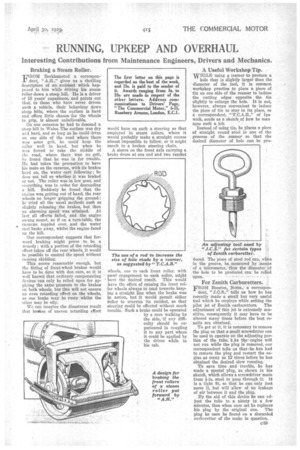RUNNING , UPKEEP AND OVERHAUL
Page 79

If you've noticed an error in this article please click here to report it so we can fix it.
Interesting Contributions from Maintenance Engineers, Drivers and Mechanics.
Braking a Stearn Roller.
FROM Berkhamsted a correspondent, " A.EL," gives us a thrilling description of an accident which happened to him while driving his steam roller dawn a steep hill. He is a driver of 15 years' experience, and points out that, to those who have never driven such a vehicle, their behaviour down steep hills, where the surface is hard and offers little chance for the wheels to grip, is almost unbelievable.
On one occasion he had to descend a steep hill in Wales. The surface was dry and_ hard, and so long as he could drive on one side of the road where there was some grit, he could keep the roller well in hand, but when he was forced to take the middle of the road, where there was no grit, he found that he was in for trouble. He had taken the precaution to have his Mate on the caravan, with its brakes hard on, the water cart following; he does not tell Us whether it was braked or not. The roller was in low gear, and everything was in order for descending a hill. Suddenly he found that the engine was getting out of hand, the rear wheels no longer gripping the ground ; he tried all the usual methods such as slightly releasing the brakes, but then an alarming speed was attained. At last all efforts failed, and the engine swung round, as if on a turn-table, the caravan toppled over, and the water Cart broke away, whilst the engine faced up the hill.
Our correspondent suggests that forward braking might prove to be a remedy ; with a portion of the retarding effort taken off the rear wheels, it would be possible to control the speed without causing skidding.
This seems reasonable enough, but the fitting of front-wheel brakes would have to be done with due care, as it is well known that ordinary compensating devices can only be relied upon for applying the sante pressure to the brakes on both wheels, but this will not ensure an even retarding effect on the wheels, as one brake may be rusty whilst the other may be oily.
We can imagine the disastrous result that brakes of uneven retarding effect would have on such a steering as that employed in steam rollers, where it would probably make a straight course almost impossible to follow, or it might result in a broken steering chain.
A sleeve on the front axle carrying a brake drum at one end and two ratchet
Wheels, one to each front roller, with pawl engagement to each roller, might have the desired result. This would have the effect of causing the front roller wheels always to tend towards keeping a straight line when the brake was in action, but it would permit either roller to overrun its ratchet, so that steering could be effected without much trouble. Such a brake could be operated by a man walking by the side, if any difficulty should be experienced in coupling it to any part where it could be applied by the driver while in his cab.
WHILE using a reamer to produce a hole that is slightly larger than the diameter of the tool, it is common workshop practice to place a piece of tin on one side of the reamer to induce the cutting edges opposite the tin slightly to enlarge the hole. It is not, however, always convenient to induce the piece of tin to stay in its place, so a correspondent, " T.C.A.B.," of Ipswich, sends us a sketch of how be man. ages such a job.
Instead of using tin, he places a piece of straight round steel.in one of the grooves of the reamer so that the desired diameter of hole can be pro For Zenith Carburetters.
FRONI )3eeston, Notts., a correspondent, "J.O.S.," tells us how he has recently made a small but very useful tool which he employs while setting the pilot jet of Zenith carburetters. The adjustment of this jet is extremely sensitive, consequently it may have to be altered many times before the best results are obtained.
To get at it, it is necessary to remove the plug so that a small screwdriver can be used to operate on the adjusting portion of the tube. '3 As the engine will not run while the plug is removed, our correspondent tells us that,he hag had to remove the plug and restart the engine as many as 12 times before he has obtained the desired slow running.
To save time and trouble, he has made a special plug, as shown in his sketch, which allows a screwdriver made from i-in. steel to pass through it. It is a tight fit, so that he can only just move it, but will allow of no leakage of air between it and the plug.
By the aid of this device he can adjust the tube to a nicety in a few minutes, then when once set he replaces his plug by the original one. The plug he uses he found on a discarded carburetter of the make in question.




























































































































